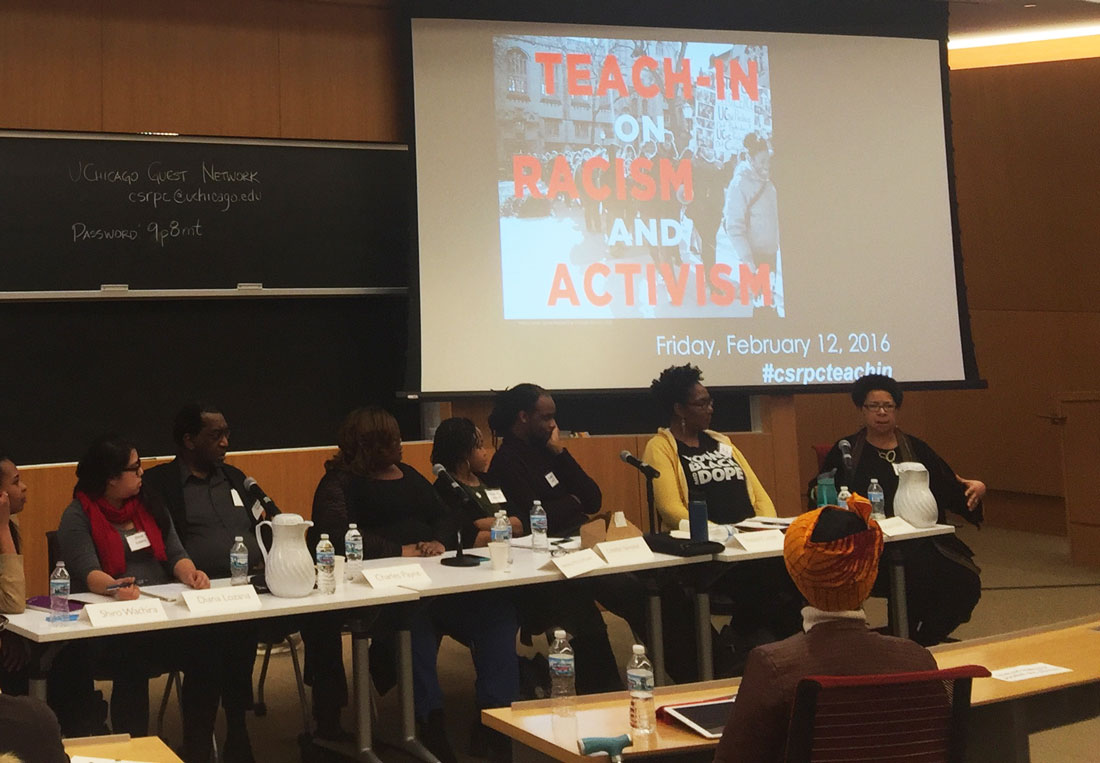By Meggie Morris
Two weeks after Buzzfeed leaked emails from a University of Chicago fraternity, revealing four years of racist and misogynistic sentiment, students, faculty and local organizers gathered last week to discuss the complexities of racism and activism.
As social justice movements gain momentum and exposure nation-wide, activists remain concerned about the balance between exclusive and collaborative spaces needed for effective activism. While students and younger activists voiced the need for exclusivity, professors said sustainable movements require coalition work.
This complicated tactical divide was palpable during demonstrations at the University of Missouri late last year. While protesting a string of on campus racial incidents, student and community groups called for the exodus of white media, and used Twitter to ask white allies to leave a gathering in order to create a black-only healing space.
Black only healing space for the students to share, decompress, be vulnerable & real. #ConcernedStudent1950 pic.twitter.com/TGr2b8UBhg
— Johnetta Elzie (@Nettaaaaaaaa) November 12, 2015
Veronica Morris-Moore, who grew up in Chicago’s South Shore neighborhood, spent five years fighting for a trauma center on the South Side before the University of Chicago agreed last September. The campaign is the perfect example of balancing cooperation with exclusivity, said Morris-Moore, co-founder of Fearless Leading by the Youth, the organization that launched the campaign.
The coalition of different community members, youth activists and religious and political leaders, who all had a stake in the trauma center, recognized that the campaign should be led by black youth whose lives were impacted by the center’s absence, she said.
Morris-Moore stressed that a coalition works best “when we can all come and work together, but still have a very important finger on what is the priority.”
Coalition building needs a stable foundation on which to stand, agreed trauma center advocate Toussaint Losier, now assistant professor of Afro-American studies at the University of Massachusetts Amherst. Young black people initiated action for the center, and once their mobilization was focused, other community groups joined them, he said. In the context of broader activism, however, most movements are not ready to collaborate, he added.
“Serious work needs to be done to challenge the lack of… real community organizing around the kind of bread and butter issues,” Losier said. “That has to happen to really be in the position to effectively and authentically do coalition building. And we’re not there yet.”
As part of last November’s demonstrations following the release of footage showing a white police officer fatally shooting Chicago teenager Laquan McDonald 16 times, protestors also called for a black-only healing space.
This request can be understood as another example of the black community wanting to control their own message and movement.
Occasional exclusivity is a choice that makes a statement about a broad disconnect to marginalized communities, said student activist and Black Youth Project 100 (BYP100) member Cosette Hampton, from far south side Roseland.
“Criticism that I’ve heard from a lot of non-black folks about BYP is, why are we a black-only organization?” she said. “That same criticism came for the Black Panther Party, and I think it’s important to realize… we have to turn our view to look at the communities that we’re a part of.”
When people are drawn to help other hurting communities, it is honorable but voyeuristic, Hampton added. Instead, people should focus on improving attitudes within their own communities before they look to coalition work.
Black-only spaces allow the black community to navigate their own differences to strengthen their movement enough to invite collaboration, said international student Shiro Wachira.
“How can we navigate these different forms of blackness?” said Wachira, originally from Kenya. “This is the importance I think of creating black-only spaces.”
Asking how activists can expand their work to incorporate other groups, however, is an important question, said Marci Ybarra, Assistant Professor in the University of Chicago School of Social Service Administration.
“One of the ways we know to sustain movements is to… have more people have a shared interest in what you’re advocating for and [more people] able to attach and identify with that,” she said.
Dr. Barbara Ransby, Professor of Gender and Women’s Studies, African American Studies and History at the University of Illinois at Chicago, said collaboration is a necessity of contemporary society. That the Black Lives Matter movement is deeply informed by queer and feminist movements is testimony to the fact that effective activism demands collaboration, she said.


